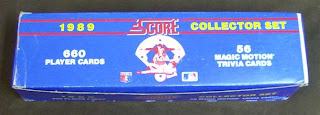The were several changes in 1993. First, the set shrunk, going from 900 cards to 660 cards. The factory set disappeared too, so it was hand-collating only. And finally, the Score rainbow was gone. All of the regular cards had the same design.

And it was a pretty minimal design.
The set remained at 660 cards in 1994, but again no factory set and no rainbow. And the design was again a very minimal one. Score really seemed to keep things simple.

Shrinkage was back in 1995 (Obligatory Seinfeld quote, "I was in the pool! I was in the pool!") and the set was down to a Score-low 605. The first set had 330 cards, the second 275. I wonder why they cut series 2?

The design team escaped its two year boring streak and came up with the dirt bike set. That's the best description I can come up with for the funky design on the sides.
The shrinkage got worse in 1996 (the pool must have been really cold!) as the set was down to only 510 cards. The design team went back to their minimalist ways, too.

I'm pretty sure that that is the Cubs 2011 11th round draft pick Shawon Dunston, Jr. in daddy's arms.
Tomorrow I'll finish up my review of Score.













































